Can Gestural Filler Reduce User-Perceived Latency in Conversation with Digital Humans?
Abstract
:1. Introduction
- RQ1:
- Can gestures of digital humans, i.e., gestural fillers, reduce perceived latency in conversation?
- RQ2:
- Does the gesture to reduce perceived latency vary by conversation type?
- RQ3:
- How do gestural and conversational fillers affect users’ perception of digital humans when delays occur during the conversation?
2. Related Work
2.1. Embodied Conversational Agents
2.2. Reducing Perceived Latency in Conversation
2.3. Non-Verbal Cues in the Conversation
3. Materials
4. Study 1
4.1. Method
4.1.1. Procedure
4.1.2. Measurements
- User-perceived latency: We measured how appropriate the response time was for participants in each condition. “The response time of the digital human I just talked to was appropriate”.
- Behavioral naturalness: The participants measured the perceived behavioral naturalness of the digital human during the latency. “The gesture of the digital human I just talked to was natural”.
- Willingness: The participants evaluated how willing they would be to interact with the digital humans. “I am willing to talk to the digital human I just talked to next time”.
- Impression: The participants evaluated the impression of the digital human. “I had a good impression of the digital human I just talked to”.
- Discomfort and competence: We used RoSAS [53] to measure these constructs. Each included three questions, and we averaged the ratings per each construct. The discomfort questions asked about the awkwardness, scariness, and strangeness of the digital human. Questions for competence were about the reliability, competence, and interactiveness of the digital human.
4.2. Participants
4.3. Hypotheses
- H1
- In the casual conversation type, the participants will evaluate the digital human with thinking motion more positively compared to one with typing motion.
- H2
- In the informative conversation type, the participants will evaluate the digital human with typing motion more positively compared to one with thinking motion.
4.4. Results
4.5. Discussion
5. Study 2
5.1. Method
5.1.1. Procedure
5.1.2. Measurements
5.2. Participants
5.3. Hypotheses
- H1
- The CF, GF, and GCF conditions will receive higher scores than NF for user-perceived latency.
- H2
- The GF and GCF conditions will receive higher scores than CF and NF for behavioral naturalness.
- H3
- The CF and GCF conditions will receive higher scores than GF and NF for willingness and impression.
- H4
- The GCF and GF conditions will receive higher scores than CF and NF for discomfort.
5.4. Results
- User-perceived latency: There were significant differences between NF and other fillers (CF, GF, and GCF > NF, in all p < 0.001), supporting H1. We also found a significant difference between CF and GCF (p = 0.036). However, the results did not reveal any statistical differences between GF and GCF and between GF and CF (See Figure 8a and Table 3).
- Behavioral naturalness: Pairwise comparisons revealed that there were statistically significant differences between NF and GF (p < 0.001), NF and GCF (p < 0.001), CF and GF (p < 0.001), and CF and GCF (p < 0.001), supporting H2. No statistical differences were found between NF and CF and GF and GCF (See Figure 8b and Table 3).
- Willingness: We found significant differences between NF and other conditions (p = 0.025, p < 0.001, p < 0.001, respectively, in the order of CF, GF, GCF), between CF and GF (p = 0.004), and between CF and GCF (p = 0.021). There was no statistical difference between GF and GCF. These results contradict our hypothesis H3 (See Figure 8c and Table 3).
- Impression: Our post hoc tests indicated statistically significant differences between NF and GF (p < 0.001), NF and GCF (p < 0.001), CF and GF (p < 0.001), and CF and GCF (p = 0.011). We, however, did not find differences between NF and CF and GF and GCF. The results for impression also do not support H3 (See Figure 8d and Table 3).
- Discomfort: Statistically significant differences were found between NF and GF (p < 0.001), NF and GCF (p = 0.031), and CF and GF (p = 0.001). In general, NF and CF received higher scores compared to GF and GCF, partially supporting H4. We did not find any statistically significant differences between NF and CF, CF and GCF, and GF and GCF (See Figure 8e and Table 3).
- Competence: Although we did not set any hypotheses on competence with regard to filler conditions, our results revealed statistically significant differences between NF and GF (p < 0.001), NF and GCF (p < 0.001), CF and GF (p = 0.004), and CF and GCF (p = 0.022). In general, participants considered digital humans competent for the conditions accompanying gestural fillers (See Figure 8f and Table 3).
5.5. Discussion
6. Conclusions
Author Contributions
Funding
Institutional Review Board Statement
Informed Consent Statement
Data Availability Statement
Conflicts of Interest
References
- Yu, F.; Jian, S.; Shen, C.; Xue, W.; Fu, Y. On the Issue of “Digital Human” in the context of digital transformation; On the Issue of “Digital Human” in the context of digital transformation. In Proceedings of the 2022 International Conference on Culture-Oriented Science and Technology (CoST), Lanzhou, China, 18–21 August 2022. [Google Scholar] [CrossRef]
- Kim, D.; Jo, D. Effects on Co-Presence of a Virtual Human: A Comparison of Display and Interaction Types. Electronics 2022, 11, 367. [Google Scholar] [CrossRef]
- Sylaiou, S.; Fidas, C. Virtual Humans in Museums and Cultural Heritage Sites. Appl. Sci. 2022, 12, 9913. [Google Scholar] [CrossRef]
- Park, S.; Kim, S.P.; Whang, M. Individual’s social perception of virtual avatars embodied with their habitual facial expressions and facial appearance. Sensors 2021, 21, 5986. [Google Scholar] [CrossRef] [PubMed]
- Jaiswal, S.; Valstar, M.; Kusumam, K.; Greenhalgh, C. Virtual human questionnaire for analysis of depression, anxiety and personality. In Proceedings of the 19th ACM International Conference on Intelligent Virtual Agents, Paris, France, 2–5 July 2019; pp. 81–87. [Google Scholar]
- Kotranza, A.; Lok, B.; Pugh, C.M.; Lind, D.S. Virtual Humans That Touch Back: Enhancing Nonverbal Communication with Virtual Humans through Bidirectional Touch. In Proceedings of the 2009 IEEE Virtual Reality Conference, Lafayette, LA, USA, 14–18 March 2009; pp. 175–178. [Google Scholar] [CrossRef]
- Krogmeier, C.; Mousas, C.; Whittinghill, D. Human, virtual human, bump! a preliminary study on haptic feedback. In Proceedings of the 2019 IEEE Conference on Virtual Reality and 3D User Interfaces (VR), Osaka, Japan, 23–27 March 2019; pp. 1032–1033. [Google Scholar]
- Hasegawa, S.; Toshiaki, I.; Hashimoto, N.; Salvati, M.; Mitake, H.; Koike, Y.; Sato, M. Human-scale haptic interaction with a reactive virtual human in a real-time physics simulator. Comput. Entertain. 2006, 4, 9-es. [Google Scholar] [CrossRef] [Green Version]
- Beacco, A.; Gallego, J.; Slater, M. Automatic 3d character reconstruction from frontal and lateral monocular 2d rgb views. In Proceedings of the 2020 IEEE International Conference on Image Processing (ICIP), Abu Dhabi, United Arab Emirates, 25–28 October 2020; pp. 2785–2789. [Google Scholar]
- Ning, Y.; He, S.; Wu, Z.; Xing, C.; Zhang, L.J. A review of deep learning based speech synthesis. Appl. Sci. 2019, 9, 4050. [Google Scholar] [CrossRef] [Green Version]
- Cudeiro, D.; Bolkart, T.; Laidlaw, C.; Ranjan, A.; Black, M.J. Capture, learning, and synthesis of 3D speaking styles. In Proceedings of the IEEE/CVF Conference on Computer Vision and Pattern Recognition, Long Beach, CA, USA, 15–20 June 2019; pp. 10101–10111. [Google Scholar]
- Yoon, Y.; Cha, B.; Lee, J.H.; Jang, M.; Lee, J.; Kim, J.; Lee, G. Speech gesture generation from the trimodal context of text, audio, and speaker identity. ACM Trans. Graph. (TOG) 2020, 39, 1–16. [Google Scholar] [CrossRef]
- Skarbez, R.; Brooks, F.P., Jr.; Whitton, M.C. A Survey of Presence and Related Concepts. ACM Comput. Surv. 2017, 50, 1–39. [Google Scholar] [CrossRef]
- Jun, H.; Bailenson, J. Effects of behavioral and anthropomorphic realism on social influence with virtual humans in AR. In Proceedings of the 2020 IEEE International Symposium on Mixed and Augmented Reality Adjunct (ISMAR-Adjunct), Recife, Brazil, 9–13 November 2020; pp. 41–44. [Google Scholar]
- Nagendran, A.; Pillat, R.; Kavanaugh, A.; Welch, G.; Hughes, C. AMITIES: Avatar-mediated interactive training and individualized experience system. In Proceedings of the 19th ACM Symposium on Virtual Reality Software and Technology, Singapore, 6–8 October 2013; pp. 143–152. [Google Scholar]
- Allouch, M.; Azaria, A.; Azoulay, R. Conversational Agents: Goals, Technologies, Vision and Challenges. Sensors 2021, 21, 8448. [Google Scholar] [CrossRef]
- Cassell, J. Embodied conversational agents: Representation and intelligence in user interfaces. AI Mag. 2001, 22, 67. [Google Scholar]
- Huang, S.; Wang, B.; Li, X.; Zheng, P.; Mourtzis, D.; Wang, L. Industry 5.0 and Society 5.0—Comparison, complementation and co-evolution. J. Manuf. Syst. 2022, 64, 424–428. [Google Scholar] [CrossRef]
- Mourtzis, D.; Angelopoulos, J.; Panopoulos, N. A Literature Review of the Challenges and Opportunities of the Transition from Industry 4.0 to Society 5.0. Energies 2022, 15, 6276. [Google Scholar] [CrossRef]
- Fitzpatrick, K.K.; Darcy, A.; Vierhile, M. Delivering cognitive behavior therapy to young adults with symptoms of depression and anxiety using a fully automated conversational agent (Woebot): A randomized controlled trial. JMIR Ment. Health 2017, 4, e7785. [Google Scholar] [CrossRef]
- Ireland, D.; Atay, C.; Liddle, J.J.; Bradford, D.; Lee, H.; Rushin, O.; Mullins, T.; Angus, D.; Wiles, J.; McBride, S.; et al. Hello Harlie: Enabling speech monitoring through chat-bot conversations. Stud. Health Technol. Inform. 2016, 227, 55–60. [Google Scholar] [PubMed]
- Denecke, K.; Vaaheesan, S.; Arulnathan, A. A mental health chatbot for regulating emotions (SERMO)-concept and usability test. IEEE Trans. Emerg. Top. Comput. 2020, 9, 1170–1182. [Google Scholar] [CrossRef]
- DeVault, D.; Artstein, R.; Benn, G.; Dey, T.; Fast, E.; Gainer, A.; Georgila, K.; Gratch, J.; Hartholt, A.; Lhommet, M.; et al. SimSensei Kiosk: A virtual human interviewer for healthcare decision support. In Proceedings of the 2014 International Conference on Autonomous Agents and Multi-Agent Systems, Paris, France, 5–9 May 2014; pp. 1061–1068. [Google Scholar]
- Cassell, J. More Than Just Another Pretty Face: Embodied Conversational Agents. Commun. ACM 2001, 43, 70–78. [Google Scholar] [CrossRef]
- Ke, X.; Hu, P.; Yang, C.; Zhang, R. Human–Machine Multi-Turn Language Dialogue Interaction Based on Deep Learning. Micromachines 2022, 13, 355. [Google Scholar] [CrossRef]
- Makhkamova, O.; Kim, D. A Conversation History-Based Q&A Cache Mechanism for Multi-Layered Chatbot Services. Appl. Sci. 2021, 11, 9981. [Google Scholar]
- Bao, S.; He, H.; Wang, F.; Wu, H.; Wang, H.; Wu, W.; Wu, Z.; Guo, Z.; Lu, H.; Huang, X.; et al. Plato-xl: Exploring the large-scale pre-training of dialogue generation. arXiv 2021, arXiv:2109.09519. [Google Scholar]
- Mathew, L.; Bindu, V. A review of natural language processing techniques for sentiment analysis using pre-trained models. In Proceedings of the 2020 Fourth International Conference on Computing Methodologies and Communication (ICCMC), Erode, India, 11–13 March 2020; pp. 340–345. [Google Scholar]
- Daher, K.; Bardelli, Z.; Casas, J.; Mugellini, E.; Khaled, O.A.; Lalanne, D. Embodied conversational agent for emotional recognition training. In Proceedings of the ThinkMind, ACHI 2020: The Thirteenth International Conference on Advances in Computer-Human Interactions, Valencia, Spain, 21–25 November 2020. [Google Scholar]
- Cassell, J.; Thorisson, K.R. The power of a nod and a glance: Envelope vs. emotional feedback in animated conversational agents. Appl. Artif. Intell. 1999, 13, 519–538. [Google Scholar] [CrossRef]
- Aneja, D.; Hoegen, R.; McDuff, D.; Czerwinski, M. Understanding conversational and expressive style in a multimodal embodied conversational agent. In Proceedings of the 2021 CHI Conference on Human Factors in Computing Systems, Yokohama, Japan, 8–13 May 2021; pp. 1–10. [Google Scholar]
- Ren, Y.; Ruan, Y.; Tan, X.; Qin, T.; Zhao, S.; Zhao, Z.; Liu, T.Y. Fastspeech: Fast, robust and controllable text to speech. Adv. Neural Inf. Process. Syst. 2019, 32, 3165–3174. [Google Scholar]
- Brown, T.; Mann, B.; Ryder, N.; Subbiah, M.; Kaplan, J.D.; Dhariwal, P.; Neelakantan, A.; Shyam, P.; Sastry, G.; Askell, A.; et al. Language models are few-shot learners. Adv. Neural Inf. Process. Syst. 2020, 33, 1877–1901. [Google Scholar]
- Hoxmeier, J.A.; DiCesare, C. System response time and user satisfaction: An experimental study of browser-based applications. In Proceedings of the Americas Conference on Information Systems, Long Beach, CA, USA, 10–13 August 2000. [Google Scholar]
- Miller, R.B. Response time in man-computer conversational transactions. In Proceedings of the December 9–11, 1968, Fall Joint Computer Conference, Part I, San Francisco, CA, USA, 9–11 December 1968; pp. 267–277. [Google Scholar]
- Shiwa, T.; Kanda, T.; Imai, M.; Ishiguro, H.; Hagita, N. How quickly should a communication robot respond? Delaying strategies and habituation effects. Int. J. Soc. Robot. 2009, 1, 141–155. [Google Scholar] [CrossRef]
- Kanda, T.; Kamasima, M.; Imai, M.; Ono, T.; Sakamoto, D.; Ishiguro, H.; Anzai, Y. A humanoid robot that pretends to listen to route guidance from a human. Auton. Robot. 2007, 22, 87–100. [Google Scholar] [CrossRef]
- Xu, D.; Zhou, A.; Zhang, X.; Wang, G.; Liu, X.; An, C.; Shi, Y.; Liu, L.; Ma, H. Understanding operational 5G: A first measurement study on its coverage, performance and energy consumption. In Proceedings of the Annual Conference of the ACM Special Interest Group on Data Communication on the Applications, Technologies, Architectures, and Protocols for Computer Communication, New York, NY, USA, 10–14 August 2020; pp. 479–494. [Google Scholar]
- Wigdor, N.; de Greeff, J.; Looije, R.; Neerincx, M.A. How to improve human–robot interaction with Conversational Fillers. In Proceedings of the 2016 25th IEEE International Symposium on Robot and Human Interactive Communication (RO-MAN), New York, NY, USA, 26–31 August 2016; pp. 219–224. [Google Scholar]
- Ohshima, N.; Kimijima, K.; Yamato, J.; Mukawa, N. A conversational robot with vocal and bodily fillers for recovering from awkward silence at turn-takings. In Proceedings of the 2015 24th IEEE International Symposium on Robot and Human Interactive Communication (RO-MAN), Kobe, Japan, 31 August–4 September 2015; pp. 325–330. [Google Scholar]
- Boukaram, H.A.; Ziadee, M.; Sakr, M.F. Mitigating the Effects of Delayed Virtual Agent Response Time Using Conversational Fillers. In Proceedings of the 9th International Conference on Human-Agent Interaction, Virtual Event, Japan, 9–11 November 2021; pp. 130–138. [Google Scholar]
- Argyle, M. Bodily Communication; Routledge: London, UK, 2013. [Google Scholar]
- Argyle, M. The biological basis of rapport. Psychol. Inq. 1990, 1, 297–300. [Google Scholar] [CrossRef]
- Hall, J.A.; Harrigan, J.A.; Rosenthal, R. Nonverbal behavior in clinician—Patient interaction. Appl. Prev. Psychol. 1995, 4, 21–37. [Google Scholar] [CrossRef]
- Cassell, J.; McNeill, D.; McCullough, K.E. Speech-gesture mismatches: Evidence for one underlying representation of linguistic and nonlinguistic information. Pragmat. Cogn. 1999, 7, 1–34. [Google Scholar] [CrossRef] [Green Version]
- Church, R.B.; Goldin-Meadow, S. The mismatch between gesture and speech as an index of transitional knowledge. Cognition 1986, 23, 43–71. [Google Scholar] [CrossRef]
- Lucas, G.M.; Rizzo, A.; Gratch, J.; Scherer, S.; Stratou, G.; Boberg, J.; Morency, L.P. Reporting mental health symptoms: Breaking down barriers to care with virtual human interviewers. Front. Robot. AI 2017, 4, 51. [Google Scholar] [CrossRef] [Green Version]
- Lugrin, J.L.; Latoschik, M.E.; Habel, M.; Roth, D.; Seufert, C.; Grafe, S. Breaking bad behaviors: A new tool for learning classroom management using virtual reality. Front. ICT 2016, 3, 26. [Google Scholar] [CrossRef] [Green Version]
- Yang, E.; Dorneich, M.C. The effect of time delay on emotion, arousal, and satisfaction in human–robot interaction. In Proceedings of the Human Factors and Ergonomics Society Annual Meeting, Washington, DC, USA, 26–30 October 2015; SAGE Publications Sage CA: Los Angeles, CA, USA, 2015; Volume 59, pp. 443–447. [Google Scholar]
- Mukawa, N.; Sasaki, H.; Kimura, A. How do verbal/bodily fillers ease embarrassing situations during silences in conversations? In Proceedings of the 23rd IEEE International Symposium on Robot and Human Interactive Communication, Edinburgh, UK, 25–29 August 2014; pp. 30–35. [Google Scholar]
- Rogers, W.T. The contribution of kinesic illustrators toward the comprehension of verbal behavior within utterances. Hum. Commun. Res. 1978, 5, 54–62. [Google Scholar] [CrossRef]
- Nomura, T.; Suzuki, T.; Kanda, T.; Kato, K. Measurement of negative attitudes toward robots. Interact. Stud. 2006, 7, 437–454. [Google Scholar] [CrossRef]
- Carpinella, C.M.; Wyman, A.B.; Perez, M.A.; Stroessner, S.J. The robotic social attributes scale (RoSAS) development and validation. In Proceedings of the 2017 ACM/IEEE International Conference on Human-Robot Interaction, Vienna, Austria, 6–9 March 2017; pp. 254–262. [Google Scholar]
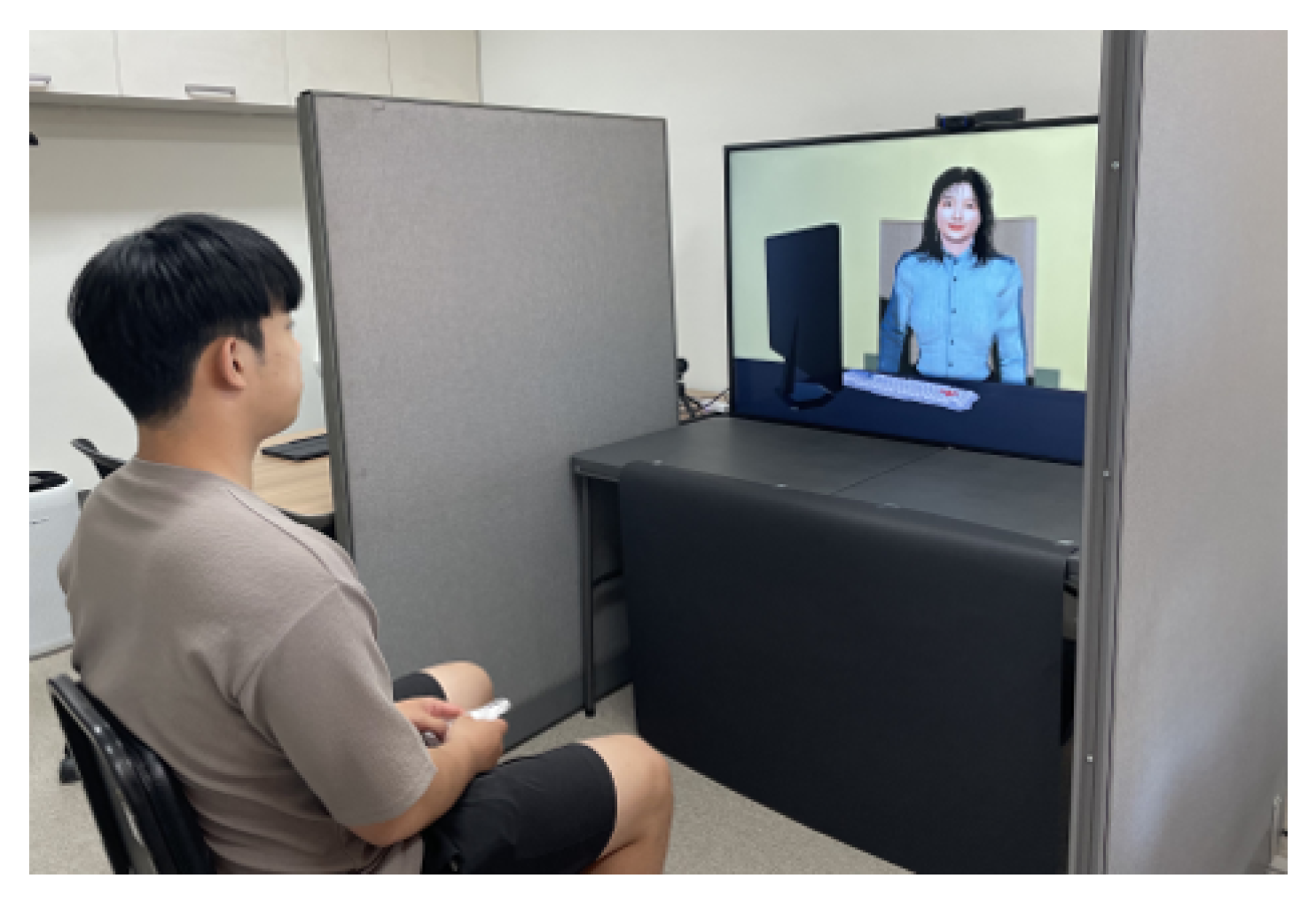

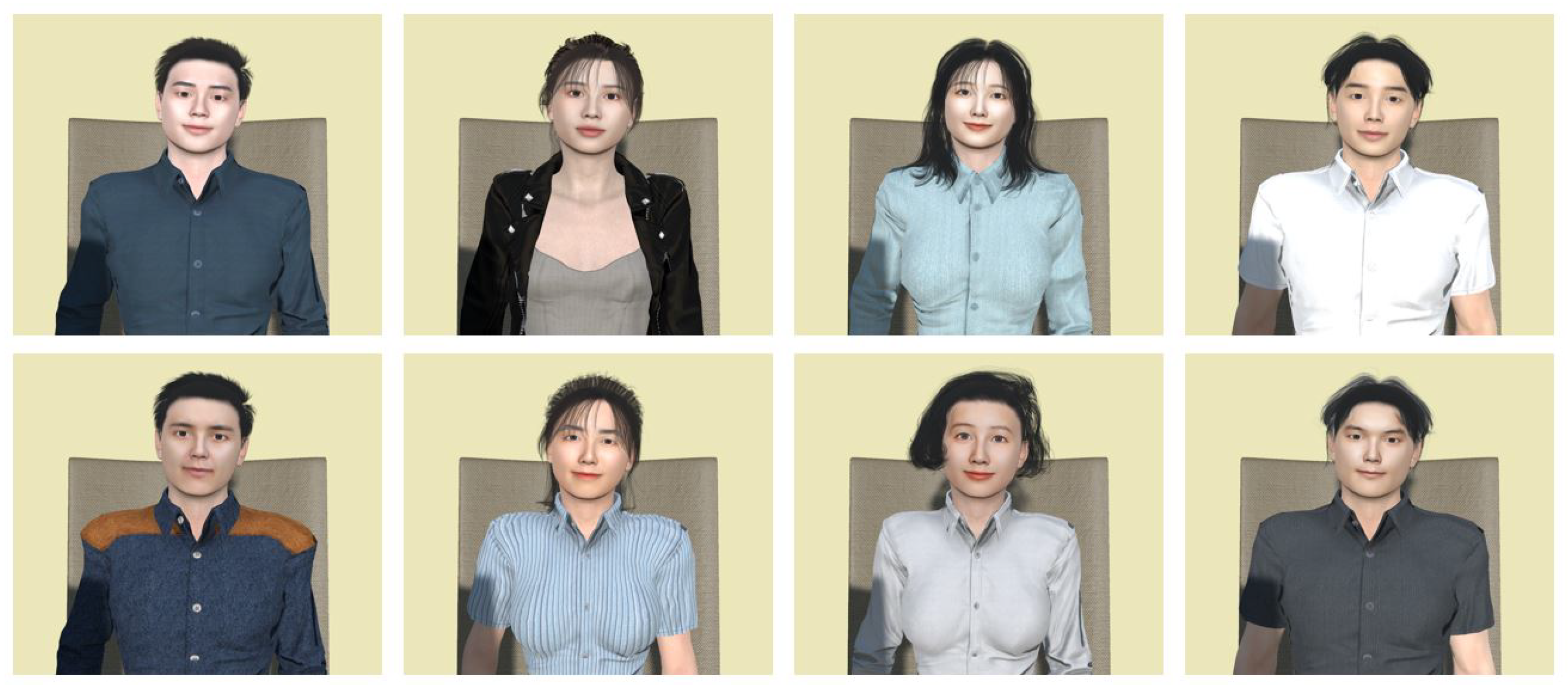

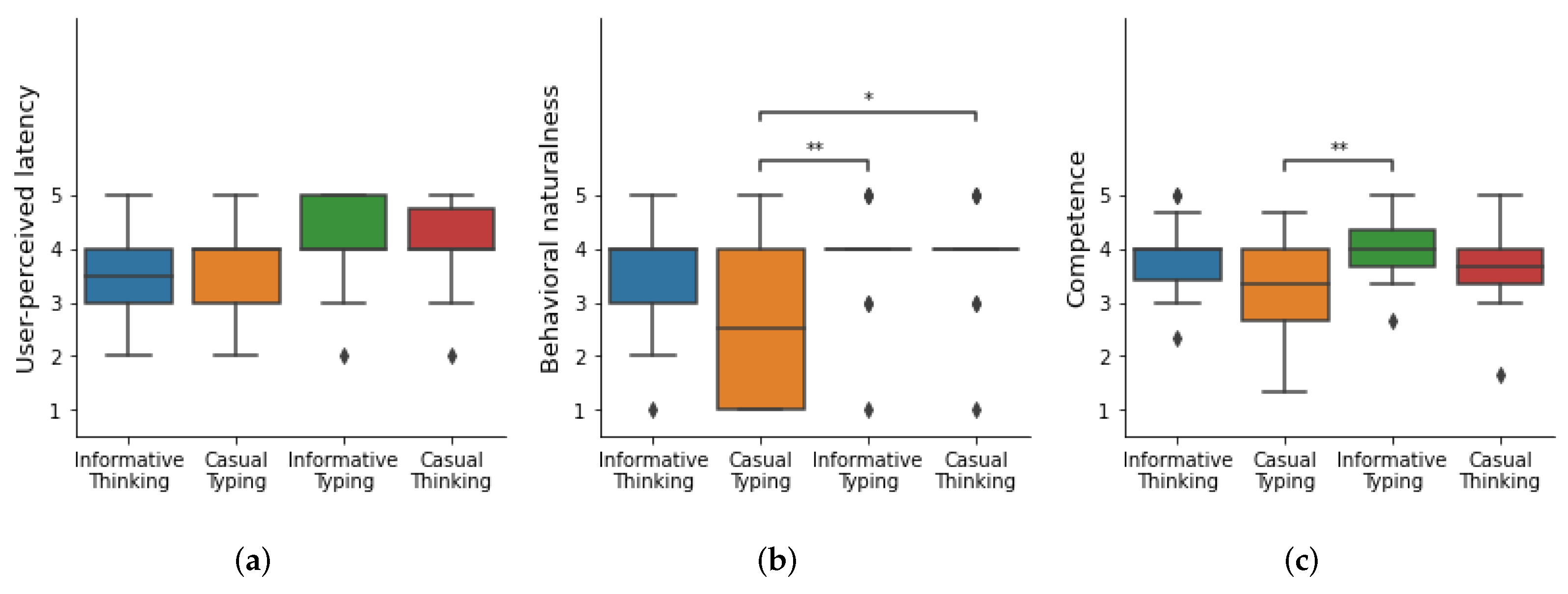
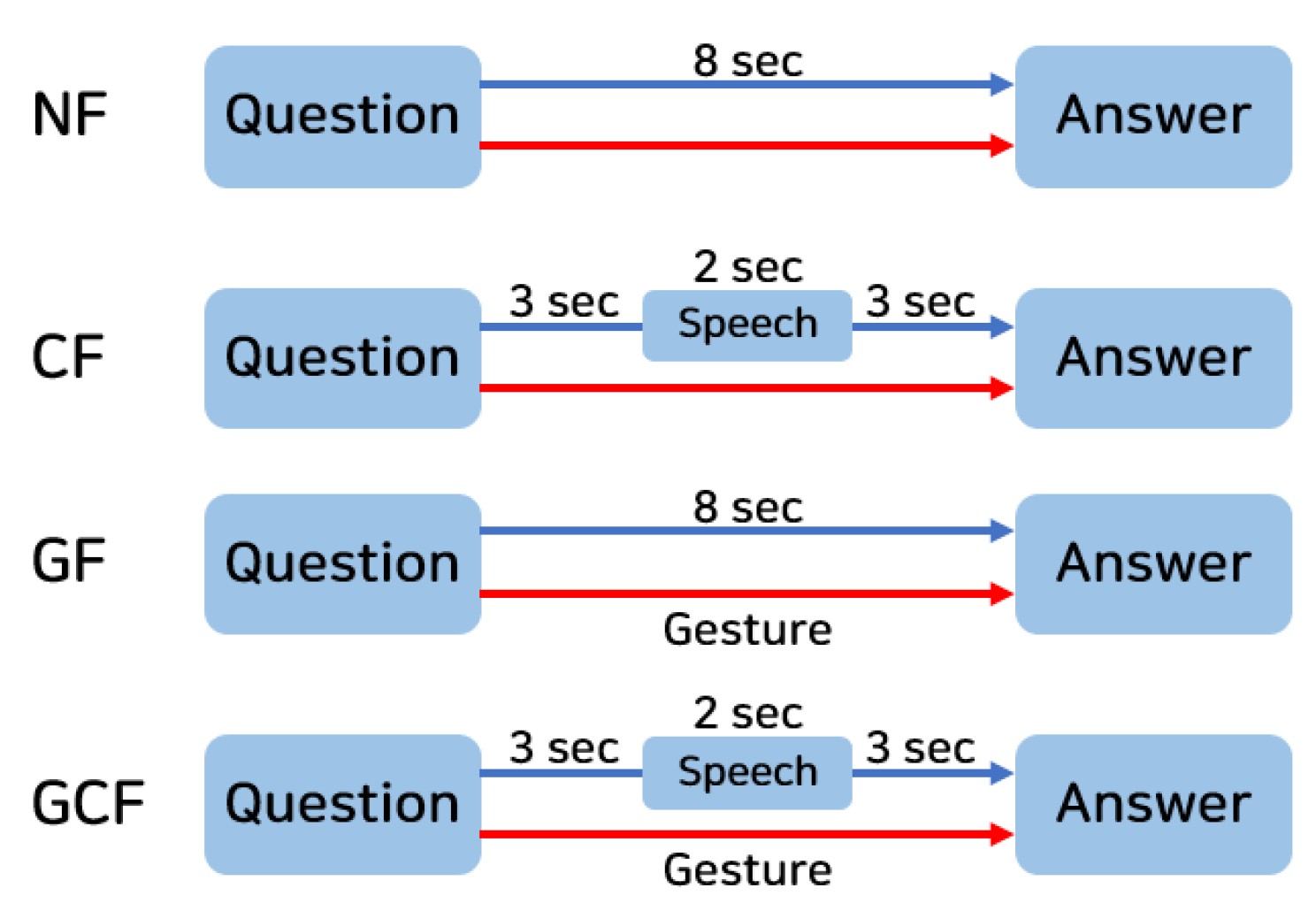
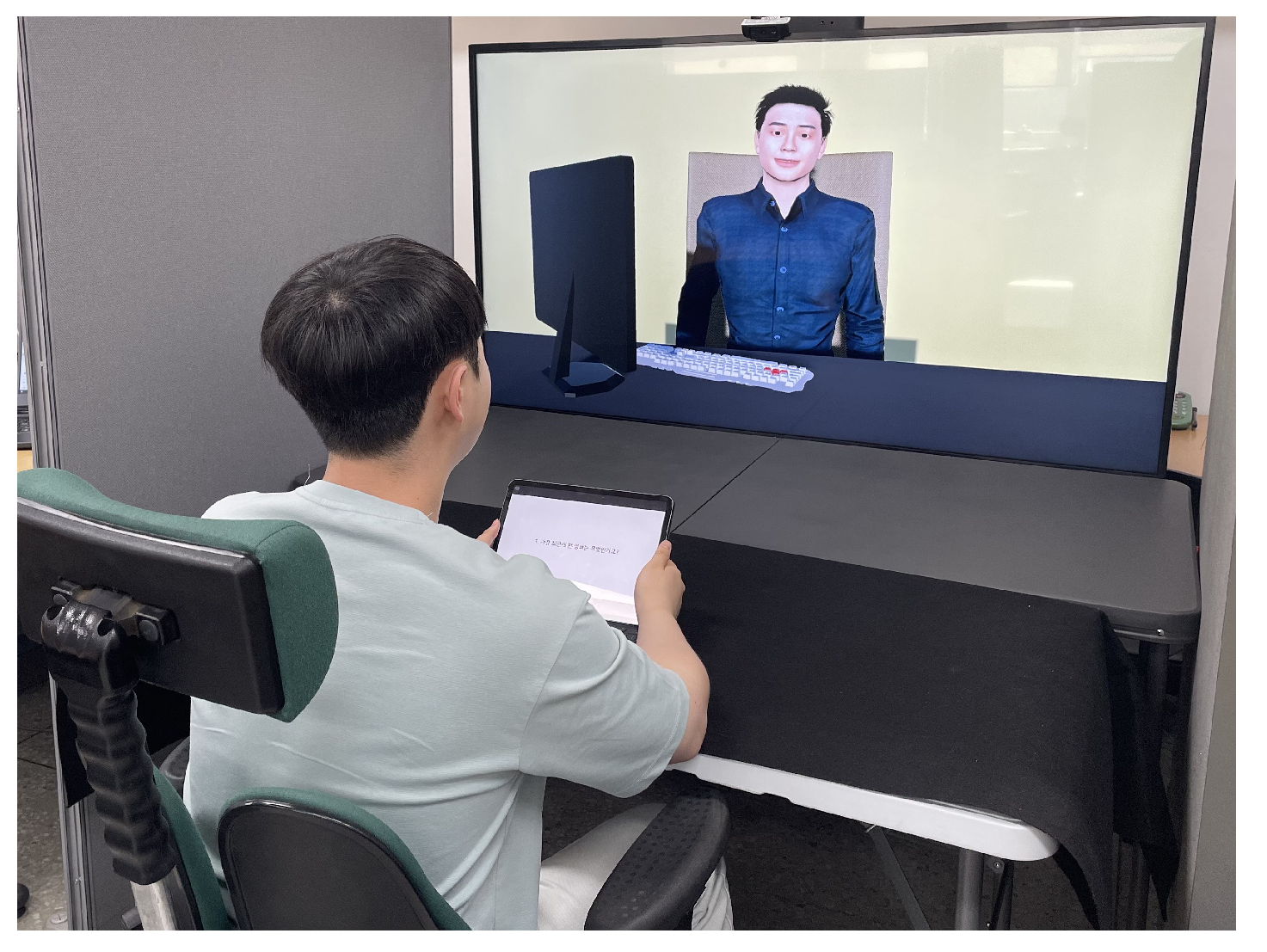
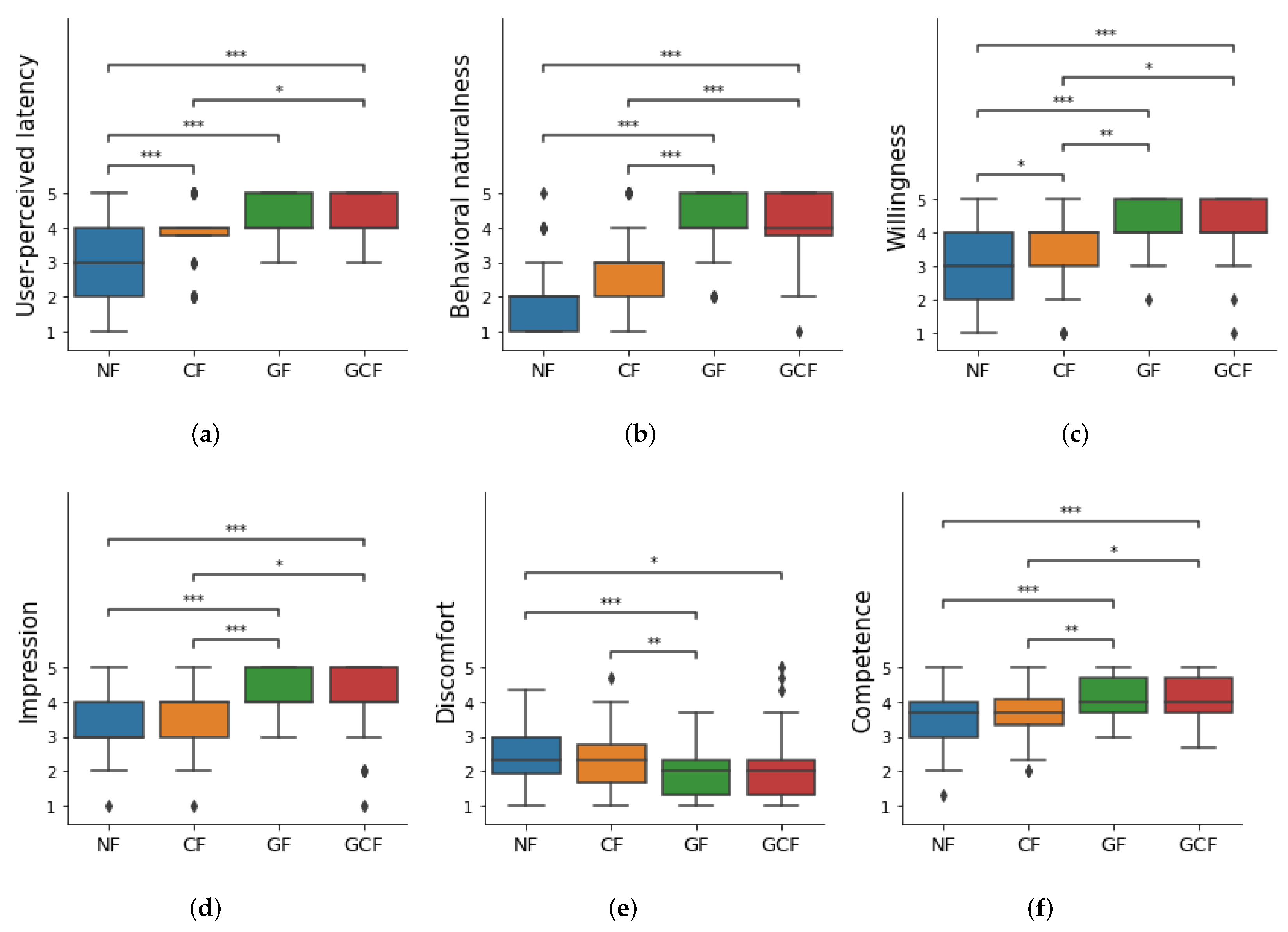

| Conversation Type | Delay | |||
|---|---|---|---|---|
| Casual | Informative | Study 1 | Study 2 | |
| 1 | What do you do for fun? | How many cafeterias are there in this campus? | non-delay | non-delay |
| 2 | Do you have any instrument you can play? | How much is breakfast? | delay | three delays were randomized |
| 3 | Is there any exercise you do regularly? | How much is lunch in cafeteria? | non-delay | |
| 4 | How do you handle your stress? | Can you tell me the hours of operation of the central library? | delay | |
| 5 | Where was your last overseas trip? | How many books can I borrow at a time in the central library? | non-delay | |
| 6 | Where do you want to travel abroad the most? | Where is the central library? | delay | |
| 7 | Where is your favorite domestic travel destination? | On which floor can I use a laptop in the library? | non-delay | |
| 8 | Do you have any vacation plans for next summer? | What application should I use to take a seat in the library? | delay | non-delay |
| p-Value | ||
|---|---|---|
| User-perceived latency | 9.246 | 0.026 |
| Behavioral naturalness | 13.720 | 0.003 |
| Willingness | 1.316 | 0.725 |
| Impression | 0.721 | 0.868 |
| Competence | 13.925 | 0.003 |
| Discomfort | 1.250 | 0.741 |
| p-Value | ||
|---|---|---|
| User-perceived latency | 59.477 | <0.001 |
| Behavioral naturalness | 66.031 | <0.001 |
| Willingness | 50.109 | <0.001 |
| Impression | 42.301 | <0.001 |
| Discomfort | 22.510 | <0.001 |
| Competence | 40.208 | <0.001 |
Publisher’s Note: MDPI stays neutral with regard to jurisdictional claims in published maps and institutional affiliations. |
© 2022 by the authors. Licensee MDPI, Basel, Switzerland. This article is an open access article distributed under the terms and conditions of the Creative Commons Attribution (CC BY) license (https://creativecommons.org/licenses/by/4.0/).
Share and Cite
Kum, J.; Lee, M. Can Gestural Filler Reduce User-Perceived Latency in Conversation with Digital Humans? Appl. Sci. 2022, 12, 10972. https://doi.org/10.3390/app122110972
Kum J, Lee M. Can Gestural Filler Reduce User-Perceived Latency in Conversation with Digital Humans? Applied Sciences. 2022; 12(21):10972. https://doi.org/10.3390/app122110972
Chicago/Turabian StyleKum, Junyeong, and Myungho Lee. 2022. "Can Gestural Filler Reduce User-Perceived Latency in Conversation with Digital Humans?" Applied Sciences 12, no. 21: 10972. https://doi.org/10.3390/app122110972






